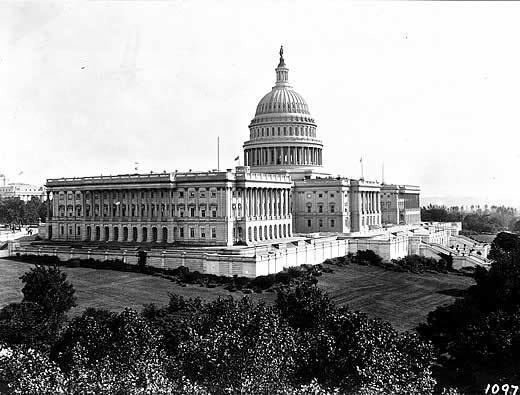The Forty-ninth United States Congress was a meeting of the legislative branch of the United States federal government, consisting of the United States Senate and the United States House of Representatives. It met in Washington, D.C. from March 4, 1885 to March 4, 1887, during the first two years of Grover Cleveland's first presidency. The apportionment of seats in the House of Representatives was based on the Tenth Census of the United States in 1880. The Senate had a Republican majority, and the House had a Democratic majority.
March 4, 1885: Grover Cleveland became President of the United StatesNovember 25, 1885: Vice President Thomas A. Hendricks diedDecember 26, 1886: Senator John A. Logan diedJanuary 19, 1886: Presidential Succession ActFebruary 4, 1887: Interstate Commerce ActFebruary 8, 1887: Dawes ActMarch 2, 1887: Hatch Act of 1887March 3, 1887: Tucker ActMarch 3, 1887: Edmunds–Tucker ActThe count below identifies party affiliations at the beginning of the first session of this Congress, and includes members from vacancies and newly admitted states, when they were first seated. Changes resulting from subsequent replacements are shown below in the "Changes in membership" section.
Democratic: 182 (majority)Republican: 141National Greenback: 1Independent Democratic: 1TOTAL members: 325
President: Thomas A. Hendricks (D), until November 25, 1885; vacant thereafterPresident pro tempore: John Sherman (R), December 7, 1885 – February 26, 1887John J. Ingalls (R), from February 26, 1887Republican Conference Chairman: George F. EdmundsDemocratic Caucus Chairman: James B. BeckDemocratic Campaign Committee Chairman: Arthur Pue GormanSpeaker: John G. Carlisle (D)Democratic Caucus Chairman: John Randolph TuckerRepublican Conference Chair: Joseph Gurney CannonSenators were elected by the state legislatures every two years, with one-third beginning new six-year terms with each Congress. Preceding the names in the list below are Senate class numbers, which indicate the cycle of their election. In this Congress, Class 1 meant their term ended with this Congress, requiring reelection in 1886; Class 2 meant their term began in the last Congress, requiring reelection in 1888; and Class 3 meant their term began in this Congress, requiring reelection in 1890.
The names of members of the House of Representatives are listed by district.
The count below reflects changes from the beginning of the first session of this Congress.
replacements: 7Democratic: 1 seat net gainRepublican: 1 seat net lossLiberal Republican: 1 seat net lossdeaths: 3resignations: 6interim appointments: 1Total seats with changes: 9replacements: 11Democratic: 2 seat net gainRepublican: 2 seat net lossdeaths: 8resignations: 7contested election: 1Total seats with changes: 16Lists of committees and their party leaders.
Additional Accommodations for the Library of Congress (Select)Agriculture and ForestryAppropriationsAudit and Control the Contingent Expenses of the SenateCivil Service and RetrenchmentClaimsCoast DefensesCommerceCompensation of Members of Congress (Select)Distributing Public Revenue Among the States (Select)District of ColumbiaEducation and LaborEngrossed BillsEnrolled BillsEpidemic Diseases (Select)Examine the Several Branches in the Civil ServiceExecutive Departments Methods (Select)Expenditures of Public MoneyFinanceFisheriesForeign RelationsIndian AffairsIndian Traders (Select)Interstate Commerce (Select)JudiciaryLibraryManufacturesMilitary AffairsMines and MiningMississippi River and its Tributaries (Select)Naval AffairsNicaraguan Claims (Select)Ordnance and War Ships (Select)PatentsPensionsPost Office and Post RoadsPotomac River Front (Select)PrintingPrivate Land ClaimsPrivileges and ElectionsPublic Buildings and GroundsPublic LandsRailroadsRevision of the LawsRevolutionary ClaimsRulesTariff Regulation (Select)Tenth Census (Select)TerritoriesTransportation Routes to the SeaboardWholeWoman Suffrage (Select)AccountsAdmission to the Floor (Select)AgricultureAlcoholic Liquor Traffic (Select)American Ship building (Select)AppropriationsBanking and CurrencyClaimsCoinage, Weights and MeasuresCommerceDistrict of ColumbiaEducationElectionsEnrolled BillsExpenditures in the Interior DepartmentExpenditures in the Justice DepartmentExpenditures in the Navy DepartmentExpenditures in the Post Office DepartmentExpenditures in the State DepartmentExpenditures in the Treasury DepartmentExpenditures in the War DepartmentExpenditures on Public BuildingsForeign AffairsIndian AffairsInvalid PensionsLaborLevees and Improvements of the Mississippi RiverManufacturesMileageMilitary AffairsMilitiaMines and MiningNaval AffairsPacific RailroadsPatentsPensionsPost Office and Post RoadsPublic Buildings and GroundsPublic LandsRailways and CanalsRevision of LawsRivers and HarborsRulesStandards of Official ConductTerritoriesWar ClaimsWays and MeansWholeConditions of Indian Tribes (Special)Scientific BureausArchitect of the Capitol: Edward ClarkLibrarian of Congress: Ainsworth Rand SpoffordPublic Printer of the United States: Sterling P. Rounds (until 1886), Thomas E. Benedict (starting 1886)Secretary of the Senate: Anson G. McCookSergeant at Arms: William P. CanadyChaplain:Elias D. Huntley, Methodist, elected December 18, 1883John G. Butler, Lutheran, elected March 15, 1886Chaplain: William H. Milburn (Methodist)Doorkeeper: Samuel DonelsonClerk: John B. Clark, Jr.Clerk at the Speaker’s Table: Nathaniel T. CrutchfieldPostmaster: Lycurgus DaltonSergeant at Arms: John P. Leedom 
